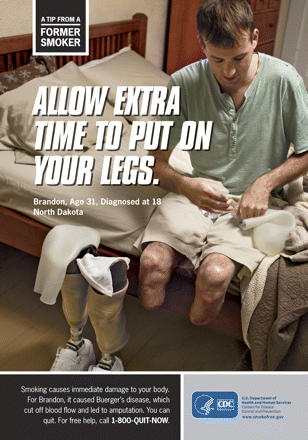Fear Factor: Should we scare people into healthy behavior?
Take a look at this video – you’re not likely to forget it. (WARNING: it contains some disturbing content):
The video is part of a series of graphic public service announcements made by the Canadian government several years ago, aimed at raising awareness about workplace safety.
Should this approach be used more in public health marketing?
It’s easy to see the rationale behind provocative ads. We’re bombarded with so much marketing that we’ve become experts at tuning much of it out. Unfortunately, that means that many useful, necessary appeals aimed at improving public health fall on deaf ears. If your job is to draw attention to public health issues – or even to sell health care products and services – it’s tempting to use graphic appeals to cut through the clutter.
And since fear is a powerful motivator – particularly when that fear involves one’s health – many public health advocates have turned to fear appeals over the years, tackling everything from cigarette smoking to STDs.
But does graphic, fear-based marketing work? The answer is: it depends.
The Scarier the Better?
 A 2000 meta-analysis in the journal Health Education & Behavior found that fear appeals can be effective in motivating audiences to accept a marketing message – especially when its recommendations seem realistic to implement. And just two weeks after the Centers for Disease Control and Prevention launched their recent “Tips from Former Smokers” campaign (see image on the right, courtesy of Centers for Disease Control and Prevention), calls to CDC’s toll-free quit line had more than doubled, and visits to its smoking cessation website had tripled.
A 2000 meta-analysis in the journal Health Education & Behavior found that fear appeals can be effective in motivating audiences to accept a marketing message – especially when its recommendations seem realistic to implement. And just two weeks after the Centers for Disease Control and Prevention launched their recent “Tips from Former Smokers” campaign (see image on the right, courtesy of Centers for Disease Control and Prevention), calls to CDC’s toll-free quit line had more than doubled, and visits to its smoking cessation website had tripled.
Yet other research casts doubt on the effectiveness of fear appeals, and even supportive research cautions that graphic fear appeals can be a double-edged sword. For instance, the Health Education and Behavior study mentioned above found that strong fear appeals were more persuasive than weak ones, but also that these strong appeals can provoke avoidance or other maladaptive reactions.
So if an ad shows a health danger that doesn’t provoke enough fear, people don’t feel motivated to change their behavior to avoid that danger. But if the ad provokes so much fear that they can’t ignore it, people may respond by avoiding the fear reaction itself, rather than the danger that causes it.
For instance, they may try to reduce their fear through denial (“That won’t happen to me”) or defensive avoidance (“This is too scary to think about.”) This is especially likely if the ad presents a threat that seems irrelevant to its intended audience, or if the suggested response to the threat seems ineffective or too difficult to attempt.
Too risky for business?
For health care businesses, fear-based appeals can be especially risky – and ethically questionable. If a health advocacy group creates a graphic PSA that sparks controversy, the consequences are likely to be minimal – and the attention could even raise the group’s public profile. But if a business offends customers with an over-the-top ad, it risks serious damage to its brand.
And though companies like Broadview Security have successfully used terrifying commercials to sell products like security systems (see video below), in an emotionally fraught field like health care, some might question whether it’s ethical for a business to drum up sales by playing off its customers’ deepest fears. Profiting from health fears can seem particularly manipulative if a company’s customers live in impoverished communities where those fears are especially potent.
And of course, fear isn’t the only way to change health behaviors. A recent study in the Journal of Marketing Research suggests that disgust can be a more powerful motivator than fear in marketing appeals. For some amusing anecdotal evidence of this, check out Ed Helms’ reaction to a commercial for Lamisil anti-fungus pills, in which a creepy yellow cartoon creature digs under a human toenail. (Video below courtesy of the Daily Show.)
| The Daily Show with Jon Stewart | Mon – Thurs 11p / 10c | |||
| Ad Nauseam – Hygiene Products | ||||
|
||||
Some public health advocates have also found greater success in “social norm” advertising. The state of Montana, for instance, switched from an ineffective fear-based campaign, featuring images of tombstones and car crashes, to a simple message of “Most of us don’t drink and drive.” For the first time, the state saw significant decreases in drunk driving following the campaign.
Still, in the perennial struggle to promote healthy behaviors in BoP communities, fear can be a tempting tool – and as you can see in the Chinese anti-smoking ad at the top of this post, it is used regularly in public health marketing around the world. But though some research suggests that fear appeals have worked in combating diseases like HIV/AIDS in Africa, there isn’t a clear consensus on whether graphic, fear-based marketing is effective or ethical in the developing world.
What do you think?
Would the image of the double amputee in the CDC anti-smoking ad above be inappropriate if it were used to illustrate the risks of diabetes – or even to sell diabetes medicine – in marketing targeted toward BoP audiences?
Is fear-based marketing manipulative or memorable? Have you seen it put to use in BoP markets, to good or bad effect? Would you use it in your own company or organization?
- Categories
- Education, Health Care, Social Enterprise
- Tags
- public health, research
